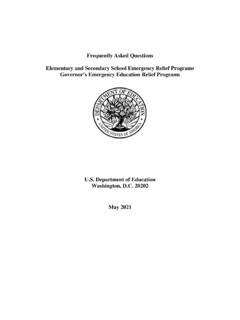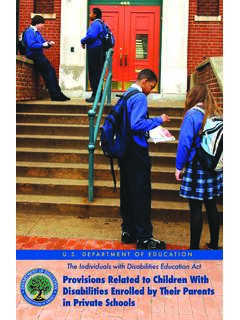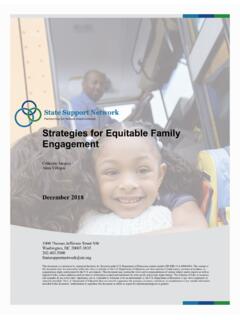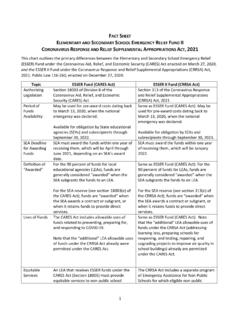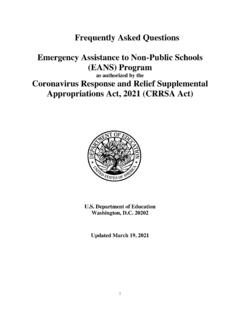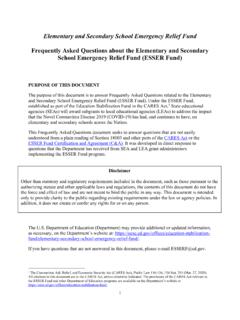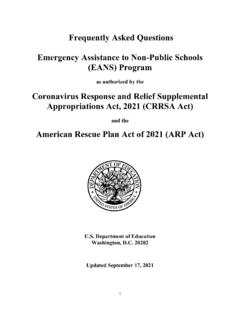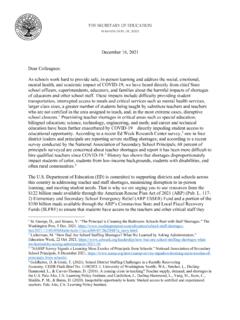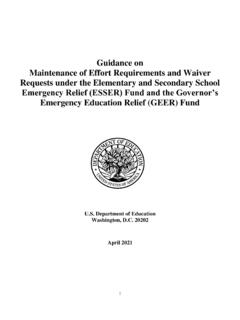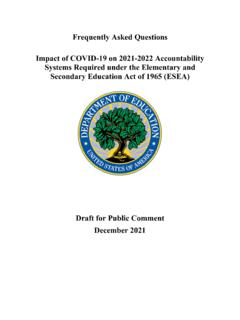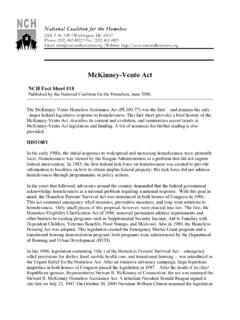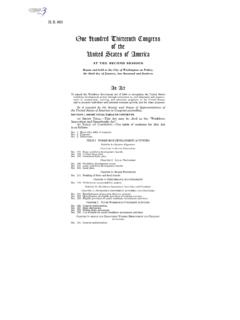Transcription of U.S. DEPARTMENT OF E F S American Rescue Plan Act of 2021 ...
1 1 DEPARTMENT OF EDUCATION FACT SHEET American Rescue Plan Act of 2021 ELEMENTARY AND SECONDARY SCHOOL EMERGENCY RELIEF FUND (ARP ESSER) This document outlines the American Rescue Plan Elementary and Secondary School Emergency Relief (ARP ESSER) Fund under the American Rescue Plan (ARP) Act of 2021, Public Law 117-2, enacted on March 11, 2021. ARP ESSER provides a total of nearly $122 billion to States and school districts to help safely reopen and sustain the safe operation of schools and address the impact of the coronavirus pandemic on the nation s students.
2 In addition to ARP ESSER, the ARP Act includes $3 billion for special education, $850 million for the Outlying Areas, $ billion to support non-public schools, and additional funding for homeless children and youth, Tribal educational agencies, Native Hawaiians, and Alaska Natives. To address the immediate needs of schools and districts, the DEPARTMENT of Education ( DEPARTMENT ) will begin making ARP ESSER funds available to States this month. ARP ESSER OVERVIEW State Allocation of ARP ESSER Funds A State must subgrant not less than 90 percent of its total ARP ESSER allocation to local educational agencies (LEAs) (including charter schools that are LEAs) in the State to help meet a wide range of needs arising from the coronavirus pandemic, including reopening schools safely, sustaining their safe operation, and addressing students social, emotional, mental health, and academic needs resulting from the pandemic.
3 The State must allocate these funds to LEAs on the basis of their respective shares of funds received under Title I, Part A of the Elementary and Secondary Education Act of 1965 (ESEA) in fiscal year (FY) 2020. The ARP ESSER Fund includes three State-level reservations for activities and interventions that respond to students academic, social, and emotional needs and address the disproportionate impact of COVID-19 on underrepresented student subgroups, including each major racial and ethnic group, children from low-income families, children with disabilities, English learners, gender, migrant students, students experiencing homelessness, and children and youth in foster care.
4 O 5 percent of the total ARP ESSER allocation for the implementation of evidence-based interventions aimed specifically at addressing learning loss, such as summer learning or summer enrichment, extended day, comprehensive afterschool programs, or extended school year programs. o 1 percent of the total ARP ESSER allocation for evidence-based summer enrichment programs. o 1 percent of the total ARP ESSER allocation for evidence-based comprehensive afterschool programs. A State may use up to of 1 percent of its total ARP ESSER allocation for administrative costs and emergency needs as determined by the State to address issues related to COVID-19.
5 2 Reservation for Homeless Children & Youth The ARP ESSER Fund also requires the DEPARTMENT to reserve $800 million to support efforts to identify homeless children and youth, and provide them with comprehensive, wrap-around services that address needs arising from the COVID-19 pandemic and allow them to attend school and participate fully in all school activities. The DEPARTMENT will award these funds expeditiously, and will work to coordinate these new resources with supports provided through the mckinney - vento Homeless Assistance Act as well as other ARP ESSER Fund activities targeting homeless children and youth.
6 LEA Use of ARP ESSER Funds Of the total amount allocated to an LEA from the State s ARP ESSER award, the LEA must reserve at least 20 percent of funds to address learning loss through the implementation of evidence-based interventions and ensure that those interventions respond to students social, emotional, and academic needs and address the disproportionate impact of COVID-19 on underrepresented student subgroups (each major racial and ethnic group, children from low-income families, children with disabilities, English learners, gender, migrant students, students experiencing homelessness, and children and youth in foster care).
7 Remaining LEA funds may be used for a wide range of activities to address needs arising from the coronavirus pandemic, including any activity authorized by the ESEA, the Individuals with Disabilities Education Act (IDEA), Adult Education and Family Literacy Act (AEFLA), or Carl D. Perkins Career and Technical Education Act of 2006 (Perkins CTE). Specifically, ARP ESSER funds may be used to develop strategies and implement public health protocols including, to the greatest extent practicable, policies in line with guidance from the Centers for Disease Control and Prevention (CDC) on reopening and operating schools to effectively maintain the health and safety of students, educators, and other staff, as well as: coordinating preparedness and response efforts with State, local, Tribal, and territorial public health departments to prevent, prepare for, and respond to COVID-19.
8 Training and professional development on sanitizing and minimizing the spread of infectious diseases; purchasing supplies to sanitize and clean the LEA s facilities; repairing and improving school facilities to reduce risk of virus transmission and exposure to environmental health hazards; improving indoor air quality; addressing the needs of children from low-income families, children with disabilities, English learners, racial and ethnic minorities, students experiencing homelessness, and foster care youth; developing and implementing procedures and systems to improve the preparedness and response efforts of LEAs; planning for or implementing activities during long-term closures, including providing meals to eligible students and providing technology for online learning.
9 Purchasing educational technology (including hardware, software, connectivity, assistive technology, and adaptive equipment) for students that aids in regular and substantive educational interaction between students and their classroom instructors, including students from low-income families and children with disabilities; providing mental health services and supports, including through the implementation of evidence-based full-service community schools and the hiring of counselors; 3 planning and implementing activities related to summer learning and supplemental after-school programs; addressing learning loss; and other activities that are necessary to maintain operation of and continuity of and services, including continuing to employ existing or hiring new LEA and school staff LEA Safe Return to In-Person Instruction Plan An LEA that receives ARP ESSER funds must, within 30 days of receiving the funds, make publicly available on its website a plan for the safe return to in-person instruction and continuity of services.
10 Before making the plan publicly available, the LEA must seek public comment on the plan. 4 Comparison of ESSER Fund (CARES Act), ESSER II Fund (CRRSA Act), and ARP ESSER (ARP Act) This following table outlines the primary differences between the American Rescue Plan Elementary and Secondary School Emergency Relief (ARP ESSER) Fund under the American Rescue Plan (ARP) Act 2021, Public Law 117-2, enacted on March 11, 2021; the ESSER II Fund under the Coronavirus Response and Relief Supplemental Appropriations (CRRSA) Act, enacted on December 27, 2020; and the ESSER Fund under the Coronavirus Aid, Relief, and Economic Security (CARES) Act enacted on March 27, 2020.
